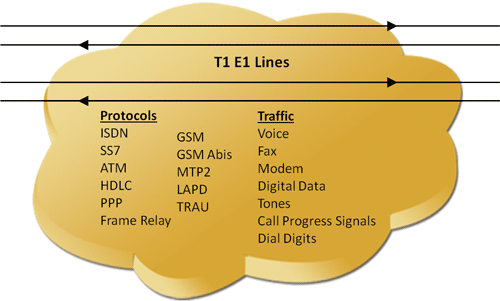Tools to Classify Traffic and Protocols over T1 E1 Lines
Gaithersburg, Maryland, USA – January 03, 2013- GL Communications Inc announced today its enhanced Protocol Identifier and Traffic Classifier tools to classify traffic and protocols over T1 E1 Lines.

Speaking to reporters, Mr. Vijay Kulkarni, CEO of the company said, “GL's Protocol Identifier and Traffic Classifier applications are ideal tools for network engineers for understanding, analyzing, and performing traffic engineering on T1 E1 networks.”
He added, “GL’s Protocol Identifier application can identify and classify various protocols carried over T1 or E1 lines. It is capable of detecting protocols such as ISDN, ATM, HDLC, MTP2, LAPD, SS7, PPP, GSM, GSM Abis, TRAU, and Frame Relay. The timeslots and or sub-channels within timeslots are also identified and after which, a detailed analysis can be carried out by individual Protocol Analyzers. This application is helpful in identifying traffic types at a concentration point, DSX patch panel, or multiplexed facility.
A companion product called Traffic Classifier is an application that can analyze different types of voiceband traffic such as voice, fax, data, tones (dial, ring etc) carried over T1 E1 lines. Traffic Classifier uses various identifying schemes depending on the country of selection and classifies the traffic, based on the dialing tones stipulated for that country.”
Mr. Kulkarni further added “Both Protocol Identifier and Traffic Classifier applications work on Windows® 32-bit and 64-bit Operating Systems. The applications can be accessed either directly or remotely.”
Important Features of Protocol Identifier
- Ability to non-intrusively characterize the protocols on T1 E1 lines in real-time
- Classification of HDLC based protocols such as ISDN, SS7, PPP, Frame Relay, and GSM
- Graphical view displays the timeslots and sub-channels of the identified protocols
- Statistical view displays the different protocols with the details of port, timeslots and sub-channels
- Stream statistics view shows the count of total number of timeslots, sub-channels, and hyper-channels used by each protocol
- Provides an option to log the protocol detected with device and channel information into a text file
- Supports filtering to display the unique selected protocol.
- Supports custom configuration of the colors to easily distinguish protocols.
Important Features of Traffic Classifier
- Ability to non-intrusively monitor voiceband traffic on a T1 E1 lines in real-time and offline modes
- Sixteen traffic types are classified, which include tones (dial, ring, busy), Voice/Speech, Data and Fax Signaling, Dialing digits (DTMF, MFR1, MFR2F, MFR2B) etc.
- Data and fax modulations such as V.22, V.34, V.29, V.32, and V.27
- Monitor T1 E1 lines locally or remotely through TCP/IP connection
- Analyze T1 E1 traffic and graphically display the results as a strip-chart
- Result options can also be saved to a file for extended periods
- Off-line (playback) feature can playback or fast forward previously recorded results
- Codecs supported - µ-Law, A-law, and linear
- Four algorithm options (Linear, quadratic, hybrid and hybrid filtered) to fine-tune the classification results
Applications
- Snapshot: Obtain a real-time snapshot of activities over T1 E1 lines
- Surveillance: Monitor all signaling and traffic events on all the timeslots/sub-channels simultaneously on multiple T1 E1 lines. You can also do surveillance for extended periods by recording the classification results for days, weeks or months at a time
- Maintenance: Helps technicians to quickly identify any content on the T1 E1 lines
- Equipment Manufactures and Equipment Vendors: Perform a pre-deployment analysis of a network so as to provide an optimized solution for your customers
- R & D, Traffic Engineering
 Back to Press Releases Index Page
Back to Press Releases Index Page